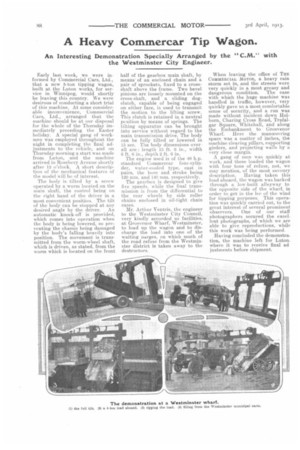A Heavy Commercar Tip Wagon.
Page 4

If you've noticed an error in this article please click here to report it so we can fix it.
An Interesting Demonstration Specially Arranged by the " C.M." with the Westminster City Engineer.
Early last week, we were informed by Commercial Cars, Ltd., that a new 5-ton tipping wagon, built at the Luton works, for service in. Winnipeg, would shortly be leaving this country. We were desirous of conducting a short trial of this machine. At some considerable inconvenience, Commercial Cars, Ltd., arranged that the machine should be at our disposal for the whole of the Thursday immediately preceding the Easter holiday. A special gang of workmen was employed throughout the night in completing the final adjustments to the vehicle, and on Thursday morning a start was made from Luton, and the machine arrived in Rosebery Avenue shortly after 12 o'clock. A short description of the mechanical features of the model will be of interest.
The body is tilted by a screw operated by a worm located on the main shaft, the control being on the right hand of the driver in a most convenient position. The tilt of the body can be stopped at any desired angle by the driver. An automatic knock-off is provided, which comes into operation when the body is being lowered, so preventing the chassis being damaged by the. body's falling heavily into position. The movement is transmitted from the worm-wheel shaft, which is driven, as stated, from the worm which is located on the front half of the gearbox main shaft, by means of an enclosed chain and a pair of sprockets fixed to a crossshaft above the irame. Two bevel pinions are loosely mounted on the cross-shaft, and a sliding dogclutch, capable of being engaged on either face, is used to transmit the motion to the lifting screw. This clutch is retained in a neutral pesition by means of springs. The tilting apparatus can be brought into service without regard to the main transmission drive. The body can be fully tilted or lowered in 15 sec. The body dimensions overall are : length 13 ft. 6 in., width 6 ft. 6 in., depth 2 ft. 6 in.
The engine used is of the 40 h.p. standard Commercar four-cylinder, water-cooled type, cast in pairs, the bore and stroke being 120 mm. and 140 mm. respectively.
The gearbox is designed to give five speeds, while the final transmission is from the differential to the rear wheels by side roller chains enclosed in oil-tight chain cases.
Mr. Arthur Ventris, the engineer to the Westminster City Council, very kindly accorded us facilities, at Grosvenor Wharf, Westminster, to load up the wagon and to discharge the load into one of the waiting oarges, on which much of the road refuse from the Westminster district is taken away to the destructors.
When leaving the office of THE COMMERCIAL MOTOR, a heavy rain storm set in, and the streets were very quickly in a most greasy and dangerous condition. The ease with which the huge machine was handled in traffic, however, very quickly gave us a most comfortable sense of security, and a run was made without incident down Holborn, Charing Cross Road, Trafalgar Square, Whitehall, and along the Embankment to Grosvenor Wharf. Here the manmuvring space was a matter of inches, the machine clearing pillars, supporting girders, and projecting walls by a very close margin.
A gang of men was quickly at work, and these loaded the wagon with four tons of refuse, not, we may mention, of the most savoury description. Having taken this load aboard, the wagon was backed through a low-built alleyway to the opposite side of the wharf, in order to get in the lee of the wind for tipping purposes. This operation was quickly carried out, to the great interest of several prominent observers. One of our staff photographers secured the excellent photographs, of which we are able to give reproductions, while this work was being performed.
Having concluded the demonstration, the machine left for Luton. where it wa-s to receive final ad justments before shipment.






















